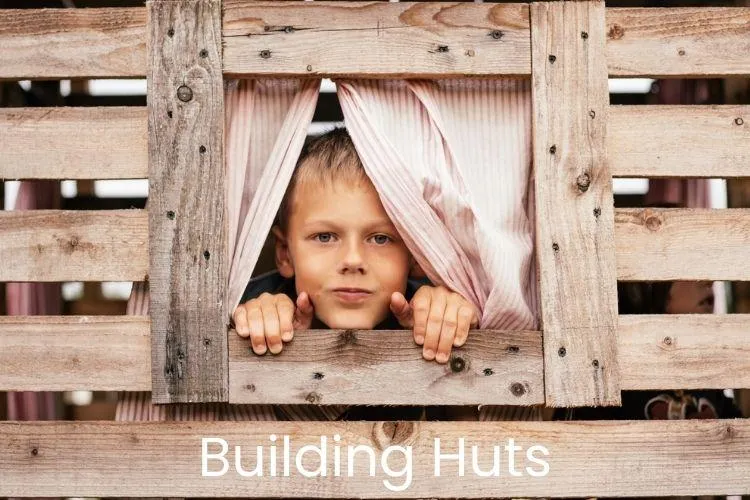

RELATIONSHIP HEALTH ARTICLES

Building Huts
“Through making their own places, children start to carve out a place for themselves in the world… We need to recognize and respect children’s need to find a place of their own as a step toward becoming their own persons.”
—David Sobel
I have three grandsons under the age of ten who were born and began their lives in Boston but moved back to the land of their roots during the uncertain days of COVID. In Boston, their outdoor life was confined to a small backyard and a municipal park a few blocks away. Today, they live on the far southern fringe of St. George, just a stone’s throw—if you are Willie Mays—from the Arizona state line. Their backyard is one of the most vast and uninhabited tracts in the lower forty-eight. It stretches all the way to Tuweep, the Grand Canyon (the Edge of the Earth, as defined by the Southern Paiute people).
A while back, as I visited with my grandson Sam, he told me about the secret “base” that he, his brothers, and their neighborhood friends had built out in the creosote and cactus not far from their homes. He didn’t tell me where it was because it was a secret, but he told me it was really neat.
It brought back memories of my own childhood. When I was Sam’s age, I, too, lived on the far southern fringe of St. George, on 600 South. From 700 South, the world was wide open all the way to the Virgin River, and from there, all the way to the Edge of the Earth.
We built a series of brush huts and underground hideouts and secret bases all across our glorious outdoor kingdom—a kingdom now covered with streets and homes and parking lots and shopping centers and more cars zooming in every direction than an eight-year-old boy could have ever imagined back in the early 1960s.
My encounter with Sam sparked a memory of something I wrote more than forty years ago. I dug it out and want to share it with you now. I think the spirit of this little fable still holds true.
You never saw a hut like the one my friend and I built back in 1963. It was a three-story job, built against the fence that separated our backyards, and even though you might have seen a fancier hut, you never saw one like we built.
It started out as a one-room clubhouse. But we kept getting these great ideas about how to expand it and make it neater. Pretty soon, it had five rooms, and we gave it trapdoors and secret entryways and even a special room to store some of our treasures, like steelies, puries, and cat-eyes, certain baseball cards, old Christmas catalogs, and unique sparkling rocks.
We were proud of that hut. We thought and talked and worried about it for hours. Mrs. Wilson, my third-grade teacher, could not keep my attention in the afternoon. Once lunchtime was over, I began counting the minutes until 3:30 and thinking about how we could make the hut neater after school.
One day, a new kid moved into the brick house down the street. He was from The City. The first thing my friend and I did was show him our hut. That hut represented the best of who and what we were—and we wanted to share it with the new kid.
“That’s the dumbest hut I ever saw,” said the new kid.
“Is not,” I indignantly replied.
“It’s a stupid hut,” the new kid said. “You guys don’t know how to make real huts around here. We make lots better huts in the city.”
“Oh, huh.”
“Do too.”
“Do not.”
We never played with the new kid after that. He was too dumb to know what a good hut was. He didn’t know how to build good huts like us guys from St. George did. We decided city kids were dumb, and we would never play with them.
During summer vacation, my friend next door went on a trip. He flew on an airplane to the city. When he came home, he told me about the big world out there.
“The city is huge,” he said. “Just the airport alone is bigger than St. George.”
The next year, the city kid moved back to the city. My friend and I kept messing around with the hut until we finally got tired of it. Boards started to fall off the walls, and we started letting little kids in the neighborhood play in it. We got involved in more important things, like stick fights with the gang down the street and excursions to the Virgin River Bridge on our bikes. Sometimes we went as far as Fossil Hill.
One day, another kid from the city moved into the brick house down the street. He wanted to play with us, but we weren’t interested. Kids from the city thought they knew everything. We knew they were really quite dumb, and we knew that he would think we were quite dumb, too. Would you show your hut to a kid from the city?
After school one day, the new boy wandered into my backyard.
“Who built that hut?” he asked as he looked over our crumbling pile of boards.
I didn’t want to tell him. It would be like throwing my best marbles to the pigs, but I had to answer.
“Me and my friend built it,” I said with as much pride as I could muster.
“That’s a neat hut,” the new boy said. “Where did you learn to build a hut like that?”
“That’s how we build huts around here,” I said.
“We build them different in the city,” the new boy said. “But I like yours. Can I play in it?”
We let him play in our hut, and pretty soon he told us some ways to make our hut even neater. He didn’t try to change it too much, but he had some neat ideas. My friend and I started getting interested in the hut again. Pretty soon, with the new guy’s help, we had the best hut around.
The other day, I asked my grandson Sam how things were going at his secret base. He looked at me matter-of-factly and said, “Oh, they tore it down and built a house there.”
